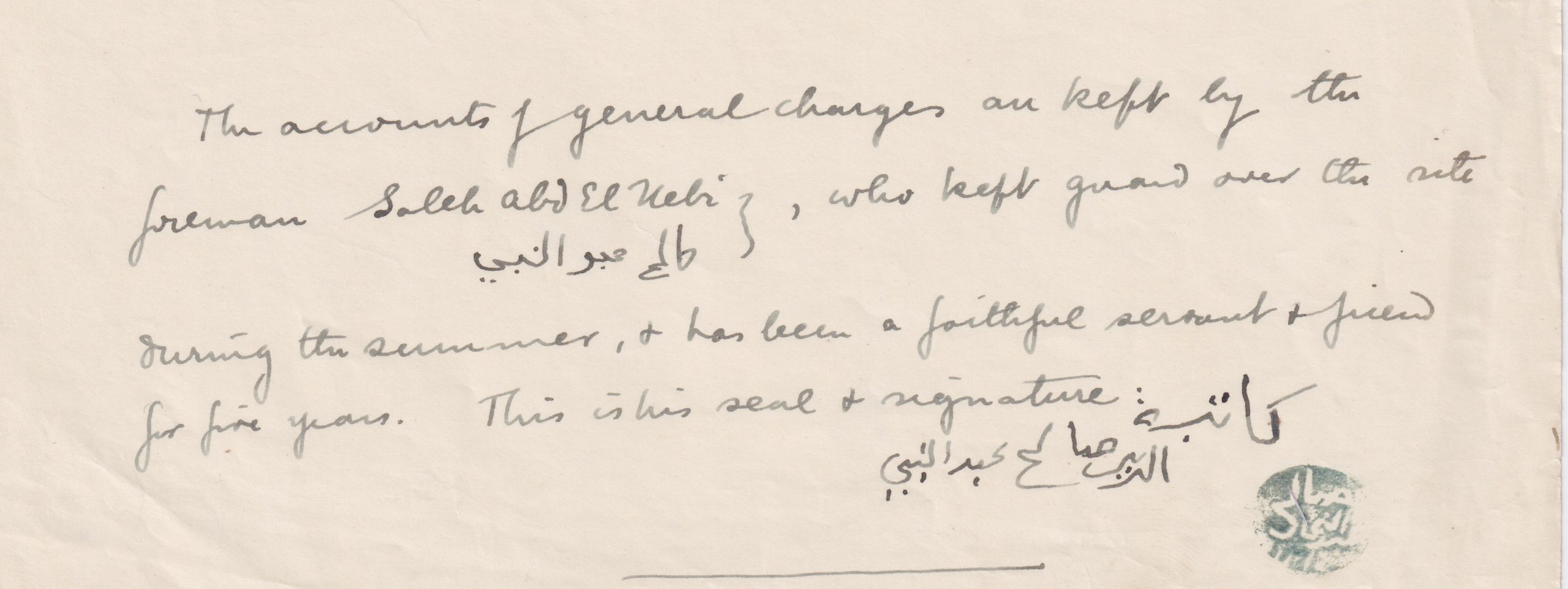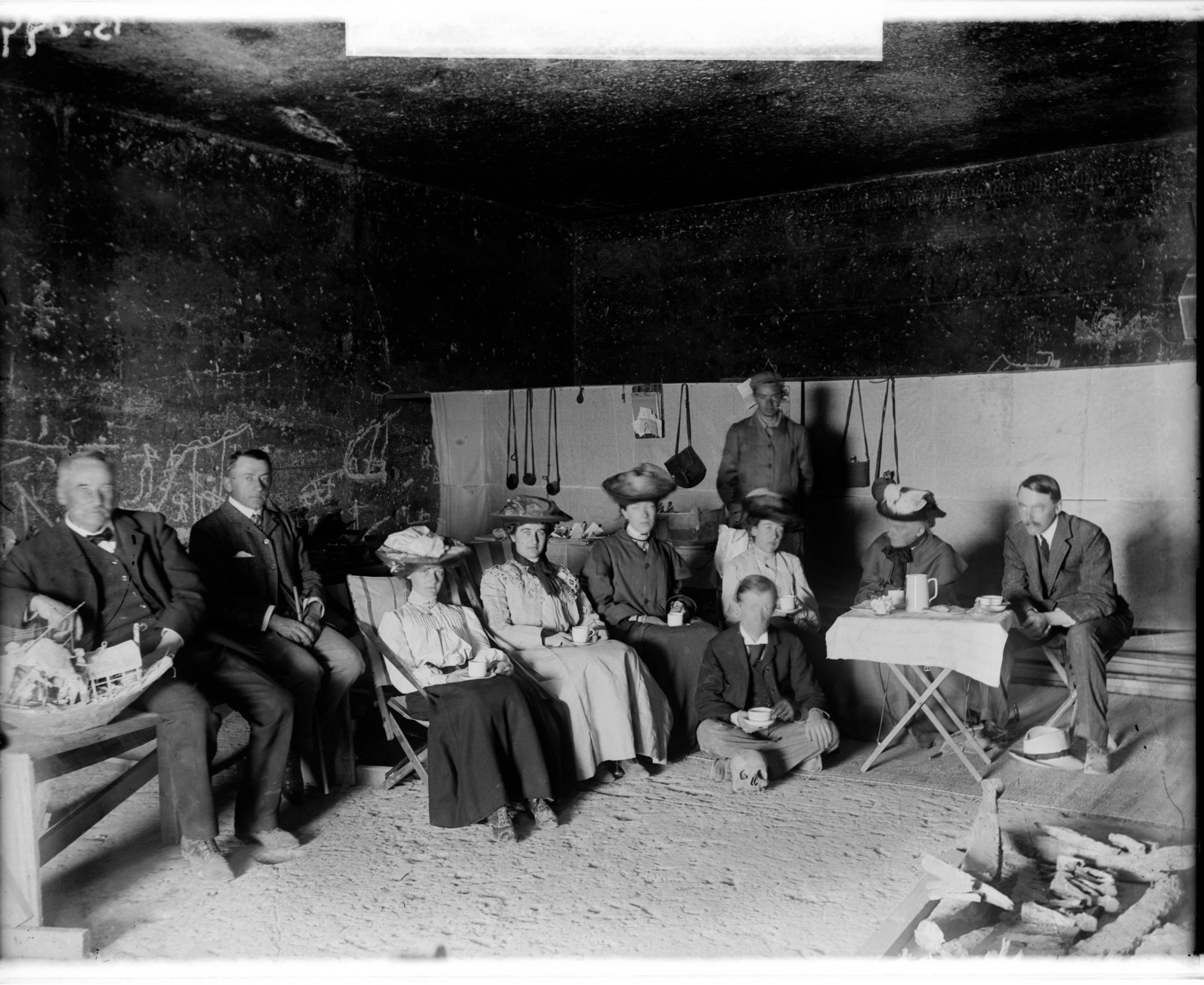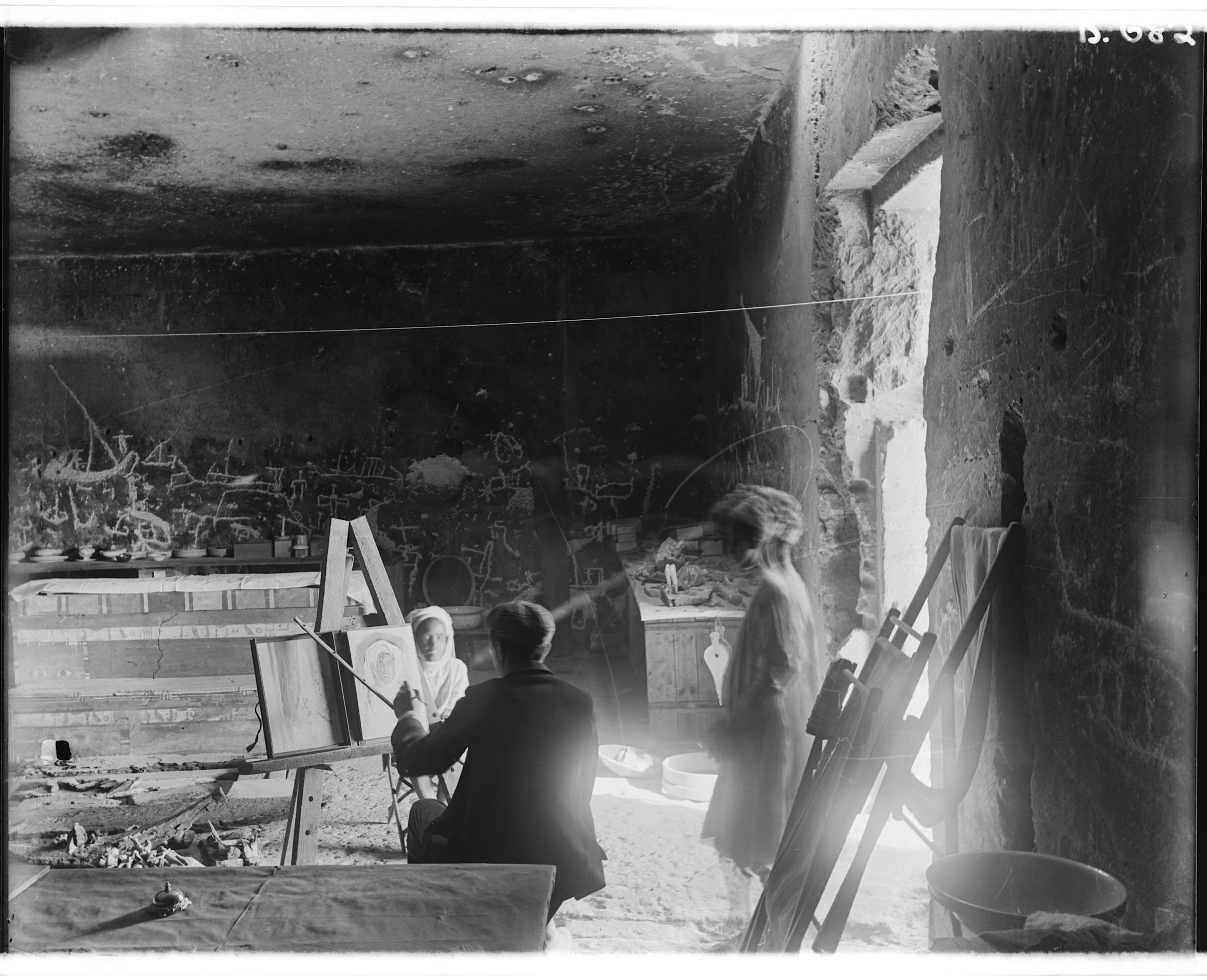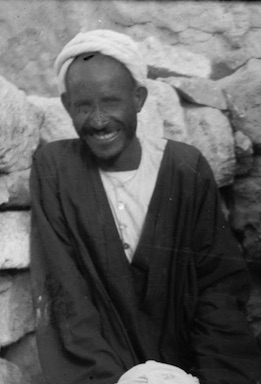By Amara Thornton (Research Officer, Ure Museum)
As ra’is (foreman) on site, Saleh Abd El Nebi was an important figure. He would have been responsible for organising a large number of people, both adults and children. He would have overseen their pay, seeing individuals were compensated for the work they had done. And he would have acted as a middle-man between British ‘archaeologists’ and the Egyptians excavating.
Although very little information is available at present about Saleh Abd El Nebi before he started working in archaeology, there are occasional references to him that reveal insights into his place in the history of archaeology in Egypt.
He appears first in a list of workers on Flinders Petrie‘s excavations at Abydos, for the 1899/1900 season. John Garstang gained his first field experience in Egypt during this season at Abydos under Petrie’s training scheme: the Egyptian Research Account. A good working relationship must have developed between the two men, as Abd El Nebi became Garstang’s main Egyptian ra’is. Years later, in his book Burial Customs of Ancient Egypt, about the excavations at Beni Hasan, Garstang wrote of the Egyptians who worked with him:
“Several of them took an intelligent interest in the excavation, the results of which astonished them not a little. Some of them have proved reliable and helpful; in particular Saleh Abd El Nebi, of Awidat, chief foreman, a man of tact in dealing with his comrades and resourceful in emergency, who has been the loyal and constant helper in many seasons’ arduous work.”
Reading between the lines of this (somewhat patronising) acknowledgement, it’s clear that Egyptians who worked on site contributed substantially to the intellectual outcomes of the excavation. In the case of Saleh Abd El Nebi, there are further sources to indicate his importance, particularly after British members of the excavation team returned to England at the end of the winter season. One of these is his signature (which includes his title as ra’is) and his seal, which appear at the end of one Garstang’s field excavation report from the 1903/4 season at Beni Hasan, reproduced for display in the “Excavating Egypt” section of the “Egypt in Reading” exhibition.

Garstang’s text in English reads:
“The accounts of general charges are kept by the foreman Saleh Abd El Nebi, who kept guard over the site during the summer, + has been a faithful friend for five years. This is his seal and signature.”
It was during this season that Queen Victoria’s youngest daughter Beatrice (Princess Henry of Battenburg) came to visit. She was in Egypt for the winter, and was on her sixth day of a tour up the Nile. The site visitors’ book from Beni Hasan (now held in the Garstang Museum archive) shows that she arrived on site on the 7th January, accompanied by her daughter Princess Victoria Eugenie, her sons Princes Leopold and Alexander of Battenburg, her niece Beatrice Princess of Coburg, and the Egyptologist Percy Newberry and Lady Mary Cecil.
They were taken to the rock-tomb ‘office’ Garstang and his assistant the artist Harold Jones used. There, antiquities were shown and interpreted. A similar scene (below) is captured in one of the photographs on display in the “Excavating Egypt” section of the “Egypt in Reading” exhibition.

The Egyptian Gazette, an English-language newspaper published in Egypt, noted of the visit that:
“…the Royal party visited some of the tombs which had been found intact…. To some of these the Princesses and Princes descended by means of ropes, and the doors were opened in their presence for the first time. Their Royal Highnesses took much interest in all they saw.”
Saleh Abd El Nebi gained his first name-check in a Western periodical for this visit. In June that year the Illustrated London News (ILN) ran an article on the exhibition of antiquities from Beni Hassan that Garstang and Harold Jones had arranged in the Society of Antiquaries, Burlington House. Among the illustrations of some of the antiquities on display is an artist’s recreation of a portrait of Abd El Nebi that Harold Jones had painted on site. Reproduced photographs showing Jones painting portraits on site are on display in the “Egypt in Britain” section of the “Egypt in Reading” exhibition.

It is this ILN-version of Abd El Nebi’s portrait that enabled me to identify him (provisionally) in one of the many uncaptioned photographs in the Beni Hassan albums now held in the Garstang Museum’s archive.

Harold Jones was left on site to tie up loose ends at the end of the season in 1904. His letters to Garstang at this time and in subsequent years very occasionally reference Saleh Abd El Nebi and his activities. It was Abd El Nebi who was responsible for arranging the construction of the dig house Garstang would use at Abydos, near the village of Arabeh al Madfuna.
In 1909, Garstang moved to Sudan to excavate. In his second season at the ancient city of Meroe (1910/11) a stunning bronze head of the Roman emperor Augustus was discovered. In the publicity attached to exhibition of Meroe artefacts the following summer in London, another reference to Saleh Abd El Nebi appears. Garstang gave an interview eventually published in the Evening Standard in which he discussed the working practices on site. Hundreds of people were employed from the local area, who were managed by a group of 30-40 foremen. Saleh Abd El Nebi was in overall charge of this system as chief foreman.
The 1913/1914 season was the last season John Garstang spent in Sudan. War broke out in August 1914, and he entered war work in France as part of the Red Cross. No records have as yet been located in England that mention what happened to Saleh Abd El Nebi after this date, though some record of him may be held in Egypt. It seems possible that he continued working in archaeology with other archaeologists. After the war, John Garstang never returned to Egypt to excavate.
References/Further Reading
Harold Jones Correspondence, Garstang Museum archive, University of Liverpool.
Meroe correspondence, Garstang Museum archive, University of Liverpool.
Beni Hasan Excavation reports, Garstang Museum archive, University of Liverpool.
Doyon, Wendy, 2015. On Archaeological Labor in Modern Egypt. In William Carruthers (ed). Histories of Egyptology: Interdisciplinary Measures. (pp. 141-156). Routledge: New York and Abingdon.
Egyptian Gazette, 1904. The Royal Visit. Excursions in Cairo. Arrangements for Nile Trip. 2 Jan: 3.
Egyptian Gazette, 1904. The Royal Tour. Visit to Excavations. 9 Jan: 3.
Garstang, John. 1907. Burial Customs of Ancient Egypt. London: Constable.
Quirke, Stephen, 2010. Hidden Hands: Egyptian workforces in Petrie excavation archives, 1880–1924. London: Duckworth Egyptology.
Petrie, W. M. Flinders, 1904. Methods and Aims in Archaeology. London: Macmillan. (See particularly Chapter III: Labourers.)
Thornton, Amara, 2018. Archaeologists in Print: Publishing for the People. London: UCL Press.

